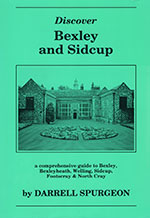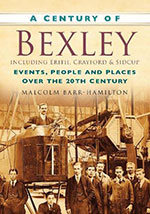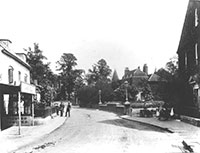Saxon Bexley
Bexley was a settlement in Kent by the River Cray.
Bexley probably meant Owood or grove of box trees.
c780 Reference to Bixle.
814 Reference to Byxlea. It was a manor of the Archbishop of Canterbury until C16.
Medieval Bexley
1086 Domesday Book listed three mills (one probably being current Old Mill) and a Saxon church in Bixle (St Mary the Virgin) where it is said that St Paulinus (died 644) came to preach.
C13 St Mary the Virgin rebuilt.
Tudor Bexley
1536 Manor of Bexley sold to Oxford University *previously owned by Archbishop of Canterbury).
c1537 Hall Place built in stone for Sir John Chapneys (1495–1556), a former Lord Mayor (1534). Stone may have been salvaged from Lesnes Abbey , one of first to be disbanded by Henry VIII in 1534.

Stuart Bexley
1649 Robert Austin (1587–1666) extended Hall Place with a second wing built of red bricks, doubling the size of the house.
1699 John Styleman (1652-1734) of the East India Company lived at Danson Estate.
Georgian Bexley
1753 Sir John Boyd, 1st Baronet Boyd (1718-1800) bought Danson Estate.
1755 Almshouses in High Street built. Money bequeathed by John Styleman.
1756 Near Bexley the Foots Cray Place mansion built by Isaac Ware (1704-1766). Only stables and walled garden remain.
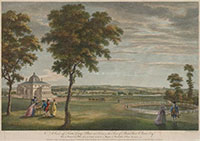
1762 High Street House built. Antiquarian John Thorpe (1715–1792) lived there.
1762 New Danson House built for Sir John Boyd. House designed by Sir Robert Taylor (1714–1788) in the Palladian style. Park landscaped by Capability Brown.
1770 The interiors of new Danson House by Sir William Chambers (1723 -1796), a friend of Sir John Boyd.
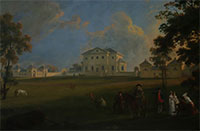
1787 Bexley Poor House built at Nos. 34-36 High Street.
1795 Hall Place leased as a school for young gentlemen
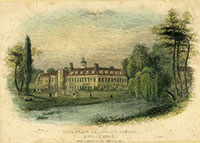
Regency Bexley
1814 Bexley heath land enclosed.
1834 Bexley National Schools built on Bourne Road.
Early Victorian Bexley
1846 Print of St Mary the Virgin, Manor Road.
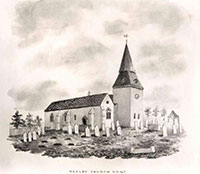
1859 Red House designed in Gothic style by Philip Webb (1831-1915) for William Morris (1834-1896) amongst what was then Kent orchards. Morris lived there for five years.
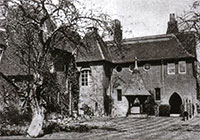
Mid Victorian Bexley
1866 Bexley Station opened.
1877 Christ Church, Bexley New Town finished. Designed by William Knight (1840-1923).
Late Victorian Bexley
Parkhurst-Knoll Road estate built west of the village for London commuters with detached and semi-detached two-storey houses in grey brick.
1882 St John the Evangelist built on Parkhill Road. Designed in French Gothic style by T George Low.
1883 Mary the Virgin restored by Basil Champneys (1842-1935).
1894 The Local Government Act created an Urban District Council for Bexley, replacing the Local Board and Parish Vestry.
Bexley New Town renamed Bexleyheath.
Victorian Freemantle Hall built at 51-75 Bexley High Street, as a community centre and focal point within the village.
1895 Bexleyheath railway line opened.
1898 Bexley (Asylum) Hospital, Old Bexley Lane, opened. Principal Architect: George Thomas Hine (1842–1916). Closed in 2001.
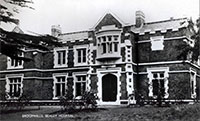
Edwardian Bexley
c. 1900 Photos of Bexley High Street
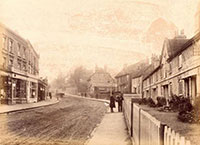
Inter War Bexley
1920 Bexley War Memorial on Hurst Road and Parkhill Road completed.
1924 Danson House & Park (200 acres) acquired by Bexley Council.
1926 Railway electrified.
1930 Bexley was still a village surrounded by countryside.
1932 Bexleyheath station, Avenue Road, rebuilt.
1934 Regal Cinema opened at 162 Broadway, Bexleyheath. Designed by Robert Cromie (1887-19??). Later an ABC (1962) and a Canon (1982). Closed in 1987.
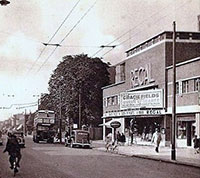
1937 Royal charter granted to Bexley, Kent, making it a Borough with its own Mayor (2:41 Pathe News film)
Bexley in WW2
Bexley suffered numerous bombings during the Second World War
1944 Hall Place, Bourne Road, used by US Army’s Signals Corps as an intercept station.
Post War Bexley
Hall Place used as an annex to the local technical school for girls.
1950 Foots Cray Place demolished after a fire in 1949.
1952 Hall Place gardens (65 hectares), Bourne Road, opened to the public.
1965 Borough of Bexley incorporated into Greater London
1966 Old Mill burned down and then rebuilt.
1968 Hall Place used as the headquarters of Bexley's Libraries and Museums service
1971 Old Bexley Conservation Area designated.
1982 Bexleyheath Shopping Centre built by Fitzroy Robinson & Partners.
1995 Danson House acquired by English Heritage.
1996 London Outer Orbital Path (LOOP) opened.
C21 Bexley
2005 Bexley Heritage Trust received a £2 million grant from the Lottery to develop Hall Place & Gardens for visitors. Riverside Cafe added alongside the River Cray, a new visitor centre and an education suite. A 17th-century stable block was converted into an art gallery. The house is used as an exhibition space.
2017 Hall Place acquired by Bexley Council from Bexley Heritage Trust.
Book List:
Discover Bexley and Sidcup - Darrell Spurgeon (1993)
Bexley and Bexleyheath: A Pictorial History -John Mercer (Phillimore 1995)
A Century of Bexley - Malcolm Barr-Hamilton (Sutton 1999)
Danson House, the anatomy of a Georgian Villa - Richard Lea et al (English Heritage 2011)
Bexleyheath A History - John Mercer (Amberley 2012)


